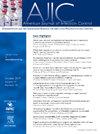优化社区养老院强化屏障防护措施的实施。
IF 3.8
3区 医学
Q2 INFECTIOUS DISEASES
引用次数: 0
摘要
背景:强化屏障预防措施(EBP)建议在与耐多药生物体(MDRO)传播有关的特定高接触护理活动中为某些养老院居民穿戴防护服和手套。尽管 EBP 作为一种 MDRO 控制策略已被纳入疾病预防控制中心指南,但最佳实施方法仍不明确:我们采用 4E 流程模型(参与、教育、执行和评估)实施了一项质量改进计划,以优化 EBP 在马里兰州四家养老院的实施。对医护人员(HCP)进行了半结构化访谈,以了解 EBP 的可接受性:结果:在高接触护理过程中,手套的使用率从基线的 85% 提高到干预期间的 97%(p 结论:EBP 的实施非常复杂,需要进行全面的评估:实施过程非常复杂,需要对每个机构内的障碍和促进因素进行全面评估。HCP访谈发现了EBP的常见障碍和促进因素,可为未来的EBP实施项目提供参考。本文章由计算机程序翻译,如有差异,请以英文原文为准。
Optimizing the implementation of Enhanced Barrier Precautions in community-based nursing homes
Background
Enhanced Barrier Precautions (EBPs) recommend using gowns and gloves for certain nursing home residents during specific high-contact care activities associated with multidrug-resistant organism (MDRO) transmission. Though EBP is included in published guidance as an MDRO control strategy, optimal implementation approaches remain unclear.
Methods
We implemented a quality improvement (QI) initiative using the 4E process model (engagement, education, execution, and evaluation) to optimize EBP implementation in 4 Maryland nursing homes. Semistructured interviews with health care personnel (HCP) occurred to understand EBP acceptability.
Results
Glove use during high-contact care increased from 85% in the baseline to 97% during the intervention (P < .01). Gown use increased from 27% to 78% (P < .01). The accuracy of identifying residents eligible for EBP improved from 63% to 99% (P < .01). Of 780 residents observed, one third met EBP indications: MDRO colonization (21%), indwelling medical device (14%), and/or chronic wound (10%). The most noted facilitator to EBP implementation included HCP perception that EBP reduces MDRO transmission to other residents and staff. The most noted barrier was uncomfortable gowns.
Conclusions
Implementation was complex and required assessments of barriers and facilitators within each facility. HCP interviews identified barriers and facilitators of EBP that can inform future EBP implementation projects.
求助全文
通过发布文献求助,成功后即可免费获取论文全文。
去求助
来源期刊
CiteScore
7.40
自引率
4.10%
发文量
479
审稿时长
24 days
期刊介绍:
AJIC covers key topics and issues in infection control and epidemiology. Infection control professionals, including physicians, nurses, and epidemiologists, rely on AJIC for peer-reviewed articles covering clinical topics as well as original research. As the official publication of the Association for Professionals in Infection Control and Epidemiology (APIC)

 求助内容:
求助内容: 应助结果提醒方式:
应助结果提醒方式:


